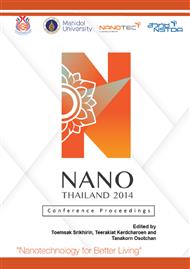[1]
B. O'Regan, M. Grätzel, A low-cost, high-efficiency solar cell based on dye-sensitized colloidal TiO2 films, Nature, 353 (1991) 737-740.
DOI: 10.1038/353737a0
Google Scholar
[2]
M. Grätzel, Solar energy conversion by dye-sensitized photovoltaic cells, Inorg. Chem., 44 (2005) 6841-6851.
DOI: 10.1021/ic0508371
Google Scholar
[3]
S. Ito, T.N. Murakami, P. Comte, P. Liska, C. Grätzel, M.K. Nazeeruddin, M. Grätzel, Fabrication of thin film dye-sensitized solar cells with solar to electric power conversion efficiency over 10%, Thin Solids Films, 516 (2008) 4613-4619.
DOI: 10.1016/j.tsf.2007.05.090
Google Scholar
[4]
B. Li, L. Wang, B. Kang, P. Wang, Y. Qiu, Review of recent progress in solid-state dye-sensitized solar cells, Sol. Energy Mater. Sol. Cells, 90 (2006) 549-573.
DOI: 10.1016/j.solmat.2005.04.039
Google Scholar
[5]
J. Wu, Z. Lan, S. Hao, P. Li, J. Lin, M. Huang, L. Fang, Y. Huang, Progress on the electrolytes for dye-sensitized solar cells, Pure Appl. Chem., 80 (2008) 20082241–2258.
DOI: 10.1351/pac200880112241
Google Scholar
[6]
Y. Wang, Recent research progress on polymer electrolytes for dye-sensitized solar cells, Sol. Energy Mater. Sol. Cells, 93 (2009) 1167-1175.
DOI: 10.1016/j.solmat.2009.01.009
Google Scholar
[7]
J.Y. Song, Y.Y. Wang, C.C. Wan, Review of gel-type polymer electrolytes for lithium-ion batteries, J. of Power Sources, 77 (1999) 183-197.
DOI: 10.1016/s0378-7753(98)00193-1
Google Scholar
[8]
G. Katoros, T. Stergiopoulos, I.M. Arabatzis, K.G. Papadokostaki, P. Falaras, A solvent-free composite polymer/inorganic oxide electrolyte for high efficiency solid-state dye-sensitized solar cells, J. Photoch. Photobio. A., 149 (2002) 191-198.
DOI: 10.1016/s1010-6030(02)00027-8
Google Scholar
[9]
G. P. Kalaignan, M.S. Kang, Y.S. Kang, Effects of compositions on properties of PEO-KI-I2 salts polymer electrolytes for DSSC, Solid State Ionics, 177 (2006) 1091-1097.
DOI: 10.1016/j.ssi.2006.03.013
Google Scholar
[10]
Y. Zhou, W. Xiang, S. Chen, S. Fang, X. Zhou, J. Zhang, Y. Lin, Influences of poly(ether urethane) introduction on poly(ethylene oxide) based polymer electrolyte for solvent-free dye-sensitized solar cells, Electrochim. Acta, 54 (2009) 6645–6650.
DOI: 10.1016/j.electacta.2009.06.064
Google Scholar
[11]
M. Chen, K.P. Ghiggino,A. Launikonis, A.W.H. Mau, E. Rizzardo, W.H. F. Sasse, S.H. Thang and G. J. Wilson, RAFT synthesis of linear and star-shaped light harvesting polymers using di-and hexafunctional ruthenium polypyridine reagents, J. Mater. Chem., 13 (2003).
DOI: 10.1039/b303576j
Google Scholar
[12]
P.P. Chu, M.J. Reddy, H.M. Kao, Novel composite polymer electrolyte comprising mesoporous structured SiO2 and PEO/Li, Solid State Ionics, 156 (2003) 141-153.
DOI: 10.1016/s0167-2738(02)00582-9
Google Scholar
[13]
Y. Yang, C.H. Zhou, S. Xu, H. Ho, B.L. Chen, J. Zhang, S.J. Wu, W. Liu, X.Z. Zhao, Improved stability of quasi-solid-state dye-sensitized solar cell based on poly(ethylene oxide)-poly(vinylidene fluoride) polymer-blend electrolytes, J. of Power Sources, 185(2008).
DOI: 10.1016/j.jpowsour.2008.09.034
Google Scholar
[14]
M.S. Skhtar, K.K. Cheralathan, J.M. Chun, O.B. Yang, Composite electrolyte of heteropolyacid (HPA) and polyethylene oxide (PEO) for solid-state dye-sensitized solar cell, Electrochim. Acta, 53 (2008) 6623-6628.
DOI: 10.1016/j.electacta.2008.04.073
Google Scholar
[15]
V. Somsongkul, C. Saekung, S.H. Thang, A. Wongchaisuwat, M. Arunchaiya, Composite poly(ethylene oxide) electrolyte modified with ethanol for dye-sensitized solar cells, Chiang Mai J. Sci., 38 (2011) 223-230.
DOI: 10.4028/www.scientific.net/msf.663-665.852
Google Scholar
[16]
S.K. Pathak, A. Abate, T. Leijtens, D.J. Hollman, J. Teuscher, L. Pazos, P. Docampo, U. Steiner, H. J. Snaith, Towards long-term photostability of solid-state dye-sensitized solar cells, Adv. Energy Mater., 20141301667 (2014) 1-9.
DOI: 10.1002/aenm.201301667
Google Scholar


